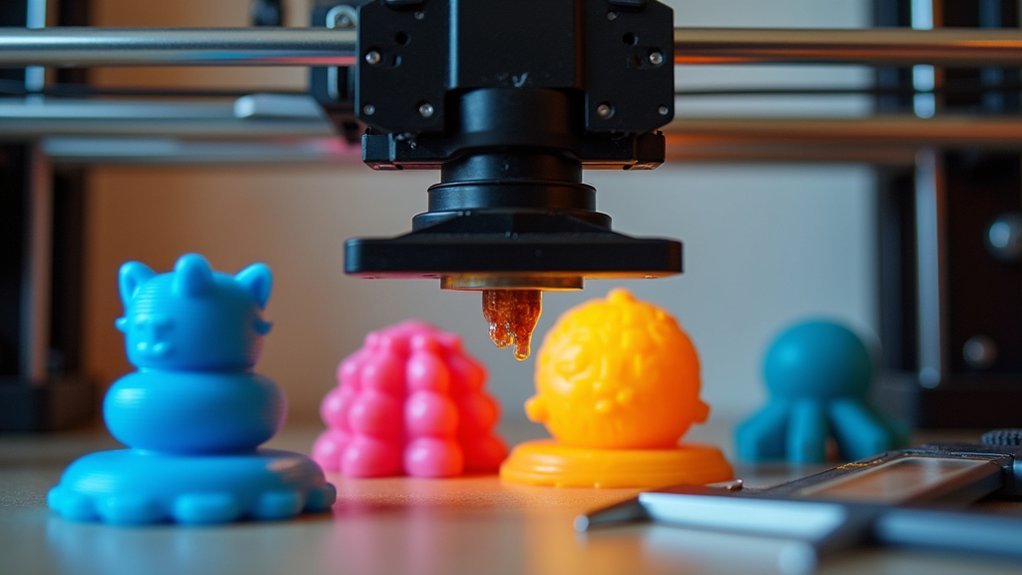You’ll get the cleanest PLA prints by setting retraction distances between 0.5-2mm for direct drive extruders or 4-7mm for Bowden systems. Start with 0.5mm for direct drive and 4mm for Bowden, then adjust in 0.5mm increments based on stringing results. Pair these settings with retraction speeds of 25-45 mm/s and consider lowering your print temperature by 5-10 degrees from the standard 210°C. The guide below reveals proven calibration methods for your specific setup.
Direct Drive Extruder Retraction Distance (0.5mm – 2mm)

When you’re using a direct drive extruder with PLA filament, you’ll need a retraction distance between 0.5mm and 2mm to minimize stringing and achieve clean prints.
Direct-drive extruders require shorter distances because they’re positioned closer to the nozzle, allowing for more precise control over the amount of filament.
Direct-drive extruders need shorter retraction distances due to their proximity to the nozzle, enabling superior filament control.
Start with 0.5mm for your initial retraction settings, then test increments of 0.5mm until you find what works best for your specific PLA brand.
Set your retraction speed between 1200-6000 mm/min to prevent filament slippage during retractions.
You’ll achieve the best results by balancing retraction distance with speed. Excessive distances increase print time and risk filament jams, so don’t exceed 2mm unless absolutely necessary for your particular printing conditions.
Bowden Extruder Retraction Distance (4mm – 7mm)
Because Bowden extruders position the motor farther from the hotend, you’ll need considerably longer retraction distances of 4mm to 7mm when printing with PLA. This extended range compensates for the longer filament pathway between the extruder motor and hot end.
Start testing at 4mm and incrementally increase based on your stringing results. Higher distances around 6-7mm may eliminate more stringing but risk filament jamming in the heatbreak.
| Retraction Distance | Recommended Use |
|---|---|
| 4-5mm | Light stringing issues |
| 5-6mm | Moderate stringing problems |
| 6-7mm | Severe stringing cases |
| Above 7mm | Risk of jamming |
| Below 4mm | Insufficient for Bowden |
Combine ideal retraction distance with appropriate retraction speed (1200-6000 mm/min) for best results with Bowden extruders.
Temperature-Based Retraction Adjustments for Different PLA Types

Optimizing retraction distance alone won’t solve stringing issues if your PLA temperature runs too hot for the specific filament type you’re using.
Different PLA brands and colors exhibit varying stringing tendencies, requiring specific temperature adjustments alongside retraction parameters. You’ll want to lower your extruder temperature by 5-10 degrees from the standard 210°C, staying within the 187-215°C range.
Special filaments like color-changing or glow-in-the-dark PLA are more stringy and need tailored temperature adjustments. If you can’t reduce temperature below 190°C without print failures, you’ll need to increase the retraction distance instead.
Test your retraction settings at different temperatures to find the ideal balance between clean prints and reliable extrusion for your specific PLA type.
Retraction Speed Settings to Prevent Filament Grinding
While proper temperature control reduces stringing, you’ll also need to dial in your retraction speed to prevent filament grinding and extruder damage.
Set your retraction speed between 20-100 mm/s, with 25-45 mm/s being an ideal starting point for most PLA filaments. Too slow allows hot plastic to ooze during travel moves, while excessive speed causes filament breakage and grinding.
This retraction setting directly impacts print quality and extruder longevity. Start with moderate speeds and adjust incrementally based on your specific printer configuration.
Higher retraction speeds can reduce overall retraction time, preventing the extruder gears from grinding the filament. Monitor your travel speed coordination with retraction settings, as the right amount of speed prevents oozing without damaging your filament feed system.
Testing and Calibrating Your Optimal Retraction Distance

After establishing the proper retraction speed, you’ll need to systematically test and calibrate your retraction distance to achieve ideal print quality.
Start with baseline values: 1-5mm for direct-drive extruders and 4-7mm for Bowden systems.
Begin calibration with proven starting points: 1-5mm retraction for direct-drive extruders, 4-7mm for Bowden setups.
Follow this testing approach:
- Print test models designed specifically to reveal stringing issues for clear visual feedback on your current setting performance.
- Make incremental adjustments of 0.5-1mm, increasing or decreasing distances based on observed results during each calibration cycle.
- Monitor filament behavior closely after each change, balancing reduced stringing against smooth extrusion without jams or pressure build-up.
Remember that different filament brands and colors often require unique tuning due to varying material properties.
Continue adjusting until you find the best retraction distance that eliminates stringing while maintaining consistent extrusion quality.
Frequently Asked Questions
What Is a Good Retraction Distance for PLA?
You’ll want 0.5-2mm for direct-drive extruders and 4-7mm for Bowden systems. Start with lower settings and increase by 1mm increments during test prints until you’ve eliminated stringing issues.
How to Tell if Retraction Is Too High?
You’ll see blobs or zits on your print’s surface when retraction’s too high. Your extruder might jam frequently, and filament won’t re-engage smoothly after retractions, causing inconsistent extrusion and poor print quality.
Does Higher Retraction Reduce Stringing?
Yes, you’ll reduce stringing with higher retraction distances because you’re pulling more filament back, relieving nozzle pressure during travel moves. However, don’t exceed recommended limits to avoid jams.
What Is the Best Retraction Distance for Cura?
You’ll want 1mm retraction distance for direct-drive extruders and 5mm for Bowden setups in Cura. Start with these values, then adjust incrementally by 1mm until you achieve ideal print quality.





Leave a Reply